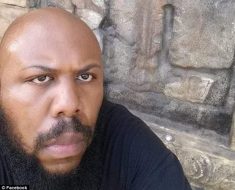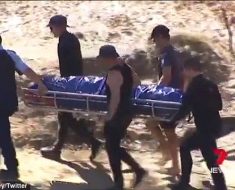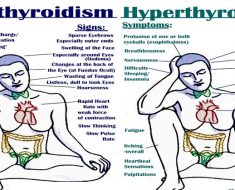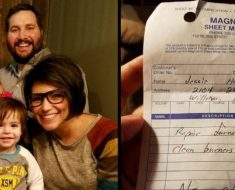
They redefined “all in the family.”
The baying vocals of one inbred family sound like a stereotype relegated to only the most exaggerated and offensive backwoods cult flicks.
However, one photographer proved that such communities do in fact exist after documenting the secret lives of the Whittakers — aka “America’s most inbred family,” whose members communicate only in grunts and bark at passersby.
“It was out of control — the craziest thing I’d ever seen” documentarian Mark Laita, 63, recalled recently on the Konkrete podcast.
He was describing his first ever encounter with the Whittakers, who reside in the rural mountain town of Odd, West Virginia, which boasts an infamously tight-knit population of around 779 people.
Laita has spent extensive time with the infamously incestuous clan, first visiting them in 2009 for his book “Created Equal” — and most recently last year for an impromptu reunion. He also chronicles this seldom-seen slice of Appalachia regularly for his podcast “Soft White Underbelly,” which specializes in “interviews and portraits of the human condition” for an audience of 4.56 million YouTube subscribers.
The surviving Whittaker family tree is currently comprised of siblings Betty, Lorraine and Ray, as well as cousin Timmy, after their brother Freddie died of a heart attack. However, there is reportedly an unnamed sister and other family members who Laita never met.
Of the three remaining relatives, only Timmy graduated high school.
During his flagship visit, the camera-wielding raconteur was approached by a shotgun-toting neighbor, who threatened to use it if the production team didn’t leave them be.
“They don’t like people coming to ridicule these people,” said Laita, who was eventually allowed to snap pictures despite the initial distrust.
Laita analogized the scene to something out of “Deliverance,” director John Boorman’s chilling, Oscar-nominated 1972 film about dueling-banjo mountain folk that’s based on the James Dickey novel of the same name.
“There’s these people walking around and their eyes are going in different directions and they are barking at us,” the astonished chronicler explained, “The one guy you’d look at him in the eye or say anything and he’d scream and go running away and his pants would fall around his ankles and he’d go running off and go kick the garbage can. This would happen over and over.”

Accompanying footage, taken from a 2021 visit, shows the family on the porch of their run-down dwelling with belongings strewn about like a scene from the Dust Bowl.
The West Virginian family has a long and complicated history of inbreeding with early reports stating that the three siblings’ now-deceased mom and dad were brother and sister.
The family later clarified that they were double first cousins — meaning that they share both sets of grandparents.
Keeping it all in the family led to a host of mental and physical aberrations with some members only communicating via grunts and squawks, as is evident in Laita’s videos posted to his podcast.
Despite their communication limitations, the Whittakers seemed to comprehend the photog’s questions.
“They understand what you talking about,” a relative told Laita. “If they don’t like it, they start yelling — let you know they don’t like that idea.”

According to Thought.Co, a hub of “expert-created education content,” inbreeding can lead to a host of side effects ranging from smaller adult size and reduced fertility to an increased risk of genetic disorders.
In rare instances, it can even lead to sapphire-colored skin, as was the case with the infamous Blue Fugates of Troublesome Creek, Kentucky.
The Whittakers didn’t seem to grasp that their genetic issues stemmed from self-pollinating the family tree. When the portraitist asked family member Kenneth why their eyes weren’t facing forward, the man responded, “might be coal mining.”
Naturally, Laita’s series might seem exploitative, akin to a carnival side show. Melody West and Shane Simmons of the Real Appalachia YouTube channel recently accused the documentary perpetuated the Appalachian inbreeding “stereotype” that has been around “for decades.”
However, Laita, who has also shot commercials for the likes of major brands such as Nike and Apple, claimed on Konkrete that he wanted to show the “level of poverty” that the Whittakers faced.

The photog has since set up a GoFundMe to help the West Virginian clan with “with living expenses and home improvements.” It has raised nearly $50,000 of its $75,000 goal.
In a video taken during Laita’s most recent visit in 2022, Ray is seen taking the photographer on a “Cribs”-style tour around their newly-renovated domicile, which now has a refrigerator, bed with a box spring, and other amenities thanks to the fundraising efforts.
At one point, Ray squawks excitedly while showing Laita a dent in their new truck from where it hit a deer.

Laita first encountered the Whittakers in 2004.
Laita, for one, says that ultimately his goal is to shed light on issues in parts of the country that people seldom see.
“People can say that people in Appalachia are leading these wonderful lives, leave them be,” he explained. “But they could also get a lot more support from the government or corporations or something so they could not be digging up roots in the middle of the winter, climbing mountains to survive on $10,000 a year.”
He added, “Despite the fact that they don’t complain, it’s a really rough life.”





